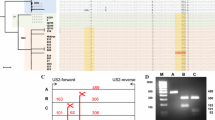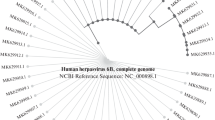Summary
Analyses of restriction fragment length polymorphism (RFLP) of herpes simplex virus type 1 (HSV-1) isolated in Japan using restriction endonucleases recognizing 6-base pairs revealed the presence of two predominant genotypes of F1 and F35. Therefore, the possibility that the two predominant genotypes may differ in clinical manifestations had to be considered. To address the question of whether differences in genotype would reflect clinical presentations of HSV-1 infection, RFLP markers to differentiate strains of predominant genotypes are required. In the present work, DNAs of 66 HSV-1 strains were analyzed, using restriction endonucleases recognizing 4-base pairs ofHaeIII,HhaI, andMboI, the objective being to detect a large number of RFLP. The relationship between the 154 identified RFLPs and each predominant genotype of F1 and F35 was traced. RFLPs closely related to each predominant genotype were manifested, as the first case of a set of RFLPs diagnostic for the predominant genotypes. These diagnostic RFLPs will facilitate knowledge on association of predominant genotypes with clinical manifestations by efficiently identifying HSV-1 strains of a genotype, and, in addition, HSV-1 strains of a predominant genotype derived from a common ancestor.
Similar content being viewed by others
References
Abdel-Hamid M, Chen J-J, Constantine N, Massoud M, Raab-Traub N (1992) EBV strain variation: geographical distribution and relation to disease state. Virology 190: 168–175
Al-Ahdal MN, Kessie G, Taha MA, Al-Shammary FJ, Ettayebi M (1992) Genomic variation among herpes simplex virus type 1 strains: virus DNA analysis of isolates from Saudi patients. J Med Virol 38: 16–21
Alam TM, Joncas JH, Ozanne G (1989) DNA polymorphism among isolates from multiple sites of a patient with chronic herpes simplex virus, type 1 infection. J Med Virol 29: 186–191
Buchman TG, Roizman B, Adams G, Stover BH (1978) Restriction endonuclease fingerprinting of herpes simplex virus DNA: a novel epidemiological tool applied to a nosocomial outbreak. J Infect Dis 138: 488–498
Casey JL, Brown TL, Colan EJ, Wignall FS, Gerin JL (1993) A genotype of hepatitis D virus that occurs in northern South America. Proc Natl Acad Sci USA 90: 9016–9020
Chaney SMJ, Warren KG, Kettyls J, Zbitnue A, Subak-Sharpe JH (1983) A comparative analysis of restriction enzyme digests of the DNA of herpes simplex virus isolated from genital and facial lesions. J Gen Virol 64: 357–371
Chou S (1992) Molecular epidemiology of envelope glycoprotein H of human cytomegalovirus. J Infect Dis 166: 604–607
Chen X, Pepper SdeV, Arrand JR (1992) Prevalence of the A and B types of Epstein-Barr virus DNA in nasopharyngeal carcinoma biopsies from southern China. J Gen Virol 73: 463–466
Gompels UA, Carrigan DR, Carss AL, Arno J (1993) Two groups of human herpesvirus 6 identified by sequence analyses of laboratory strains and variants from Hodgkin's lymphoma and bone marrow transplant patients. J Gen Virol 74: 613–622
Halperin SA, Hendley JO, Nosal C, Roizman B (1980) DNA fingerprinting in investigation of apparent nosocomial acquisition of neonatal herpes simplex. J Pediatr 97: 91–93
Hayward GS, Frenkel N, Roizman B (1975) Anatomy of herpes simplex virus DNA: strain differences and heterogeneity in the locations of restriction endonuclease cleavage sites. Proc Natl Acad Sci USA 72: 1768–1772
Lafferty WE, Coombs RW, Benedetti J, Critchlow C, Corey L (1987) Recurrences after oral and genital herpes simplex virus infection; influence of site of infection and viral type. N Engl J Med 316: 1444–1449
Lonsdale DM, Brown SM, Subak-Sharpe JH (1979) The polypeptide and the DNA restriction enzyme profiles of spontaneous isolates of herpes simplex virus type 1 from explants of human trigeminal, superior cervical and vagus ganglia. J Gen Virol 43: 151–171
Lung ML, Lam WP, Sham J, Choy D, Yong-Sheng Z, Guo H-Y, Ng MH (1991) Detection and prevalence of the “f” variant of Epstein-Barr virus in southern China. Virology 185: 67–71
Packham G, Brimmell M, Cook D, Sinclair AJ, Farrell PJ (1993) Strain variation in Epstein-Barr virus immediate early genes. Virology 192: 541–550
Roizman B (1979) The structure and isomerization of herpes simplex virus genomes. Cell 16: 481–494
Rojas JM, Dopazo J, Martin-Blanco E, Lopez-Galindez C, Tabares E (1993) Analysis of genetic variability of populations of herpes simplex viruses. Virus Res 28: 249–261
Sakaoka H, Aomori T, Ozaki I, Ishida S, Fujinaga K (1984) Restriction endonuclease cleavage analysis of herpes virus isolates obtained from three pairs of siblings. Infect Immun 43: 771–774
Sakaoka H, Saheki Y, Uzuki K, Nakakita T, Saito H, Sekine K, Fujinaga K (1986) Two outbreaks of herpes simplex virus type 1 nosocomial infection among newborns. J Clin Microbiol 24: 36–40
Sakaoka H, Saito H, Sekine K, Aomori T, Grillner L, Wadell G, Fujinaga K (1987) Genomic comparison of herpes simplex virus type 1 isolates from Japan, Sweden and Kenya. J Gen Virol 68: 749–764
Sample J, Young L, Martin B, Chatman T, Kieff E, Rickinson A, Kieff E (1990) Epstein-Barr virus types 1 and 2 differ in their EBNA-3A, EBNA-3B, and EBNA-3C genes. J Virol 64: 4084–4092
Skare J, Summers WP, Summers WC (1975) Structure and function of herpesvirus genomes. I. Comparison of five HSV-1 and two HSV-2 strains by cleavage of their DNA withEcoRI restriction endonuclease. J Virol 15: 726–732
Skare J, Summers WC (1977) Structure and function of herpesvirus genomes. II.EcoRI,XbaI andHindIII endonuclease cleavage sites on herpes simplex virus type 1 DNA. Virology 76: 581–595
Umene K, Eto T, Mori R, Takagi Y, Enquist LW (1984) Herpes simplex virus type 1 restriction fragment polymorphism determined using Southern hybridization. Arch Virol 80: 275–290
Umene K (1985) Variability of the region of herpes simplex virus type 1 genome yielding defective DNA:SmaI fragment polymorphism. Intervirology 23: 131–139
Umene K (1987) Restriction endonucleases recognizing DNA sequences of four base pairs facilitate differentiation of herpes simplex virus type 1 strains. Arch Virol 97: 197–214
Umene K, Yoshida M (1989) Reiterated sequences of herpes simplex virus type 1 (HSV-1) genome can serve as physical markers for the differentiation of HSV-1 strains. Arch Virol 106: 281–299
Umene K (1991) Recombination of the internal direct repeat element DR2 responsible for the fluidity of thea sequence of herpes simplex virus type 1. J Virol 65: 5410–5416
Umene K, Sakaoka H (1991) Homogeneity and diversity of genome polymorphism in a set of herpes simplex virus type 1 strains classified as the same genotypic group. Arch Virol 119: 53–65
Umene K, Yoshida M (1993) Genomic characterization of two predominant genotypes of herpes simplex virus type 1. Arch Virol 131: 29–46
Author information
Authors and Affiliations
Rights and permissions
About this article
Cite this article
Umene, K., Yoshida, M. Preparation of herpes simplex virus type 1 genomic markers to differentiate strains of predominant genotypes. Archives of Virology 138, 55–69 (1994). https://doi.org/10.1007/BF01310038
Received:
Accepted:
Issue Date:
DOI: https://doi.org/10.1007/BF01310038




